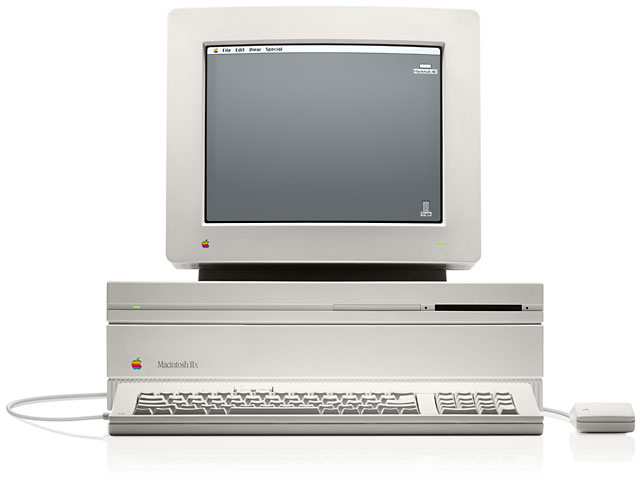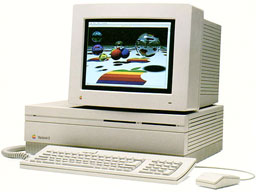Building on the success of the Mac II, the 1988 Mac IIx housed a 68030 CPU and 68882 FPU (floating point unit) in the same case. Breakthrough features included the DOS-compatible 1.4 MB SuperDrive (a.k.a. FDHD for floppy disk, high density) and virtual memory. Although advertised as a 32-bit computer, the Mac IIx ROMs were “dirty,” containing some 24-bit code. Running in 32-bit mode requires Mode32 (search the page for “mode32”).

 The IIx requires special PAL SIMMs when using 4 MB or larger SIMMs. With these it can support 128 MB.
The IIx requires special PAL SIMMs when using 4 MB or larger SIMMs. With these it can support 128 MB.
There is a ROM SIMM slot on the Mac IIx which must be filled with a IIx ROM. Without this ROM, the computer will not function.
- Got a Mac II or other vintage Mac? Join our Vintage Macs Group or Vintage Macs Forum.
- Our System 6 Group is for anyone using Mac System 6.
Upgrade Advice
If you want more speed, consider upgrading to a IIfx instead of adding an accelerator. You can easily move your video card and other accessories (but not RAM) to the new computer.
- If you’re content with performance but run out of memory, move to 8 MB ($10 or so depending on how much RAM you already have).
- Consider a Mac IIfx motherboard ($10-25). You will need to buy 64-bit SIMMs, quite possibly making this more expensive than buying a used IIfx.
- LOW END MAC BEST BUY Buy a used Mac IIfx (starting at less than $50 depending on configuration). This provides almost 3x the speed and usually 8-16 MB RAM and an 80-160 MB hard drive. Since you only have 2-8 MB in your IIx, the fact that the IIfx uses 64-bit SIMMs isn’t a big factor. You may well get an accelerated video card in the bargain.
- A newer hard drive will be larger and faster than the one Apple shipped with the computer, but you won’t be able to take full advantage of that speed on such an old computer.
- If you want to run a larger monitor, support other bit depths, or have accelerated video, check out our Guide to NuBus Video Cards. There are lots to choose from, and many of them are dirt cheap on the used market.
Details
- introduced 1988.09.19 at $7,769 ($9,269 with 40 MB hard drive); discontinued 1990.10.15
- code names: Spock, Strato
- Order no.: M5480
- Gestalt ID: 7
- upgrade path: IIfx
Mac OS
- requires System 6.0.2 to 7.5.5
- addressing: 24-bit, 32-bit requires Mode32
Core System
- CPU: 40 MHz 68030
- CPU: 16 MHz 68030
- FPU: 16 MHz 68882
- ROM: 256 KB
- RAM: 1 MB, expandable to 128 MB using both 4-SIMM banks of 120ns 30-pin memory; supports 256 KB, 1 MB, 4 MB, and 16 MB SIMMs; 4 MB and 16 MB must be PAL SIMMs
Performance
- 2.9, relative to SE
- 3.9 MIPS
- 3.4, Speedometer
Graphics
- video: requires video card – see our Guide to NuBus Video Cards for more information.
Drives
- Hard drive: 40 or 80 MB 5.25″
- floppy drive: 1.4 MB double-sided
- internal bay for second floppy drive
Expansion
- ADB ports: 2
- serial ports: 2 DIN-8 RS-422 ports on back of computer
- SCSI ports: DB-25 connector on back of computer
- sound: 8-bit stereo
- NuBus slots: 6
Physical
- size (HxWxD): 5.5″ x 18.7″ x 14.5″
- Weight: 24 lbs.
- PRAM battery: 3.6V half-AA
- power supply: 230W
Accelerators & Upgrades
- Apple Macintosh IIfx motherboard (40 MHz 68030, uses 64-pin SIMMs)
- Daystar Turbo 040 (33 MHz, 40 MHz 68040), discontinued
- MicroMac Diimo/030 (50 MHz 68030), 64 KB cache, optional 50 MHz 68882 FPU
- MicroMac Carrera (33 MHz and 40 MHz 68040), optional 128 KB cache
- MicroMac 90 MHz Carrera (45 MHz 68040)
- Sonnet Technologies Allegro IIx (33 MHz 68030), discontinued
Accelerator Reviews
Online Resources
Cautions
- Never connect an Apple II 5.25″ floppy drive to the Mac’s floppy port. Doing so can ruin the floppy controller, meaning you can’t even use the internal drive any longer.
- Mode32 or Apple’s 32-bit Enabler required to access more than 8 MB RAM. (Mode32 v7. works with System 7.5; Apple’s enabler does not.)
- Internal video on the IIci and IIsi, and the Mac II mono and color video cards, will not work with multisync monitors, whether Apple or PC style. Griffin Technology made the Mac 2 Series Adapter, which works with Apple’s Multiple Scan monitors and most Mac compatible monitors. There was also a version for using VGA-type monitors on older Macs.
- Serial port normally restricted to 57.6 kbps; throughput with a 56k modem may be limited. See 56k modem page. For more information on Mac serial ports, read Macintosh Serial Throughput in our Online Tech Journal.
- Apple discontinued support and parts orders for the IIx on 1998.08.31. You may be able to find dealers with parts inventory either locally or on our parts and service list.

Keywords: #maciix #macintoshiix
Short link: http://goo.gl/5Te5rX
searchwords: maciix, macintoshiix




